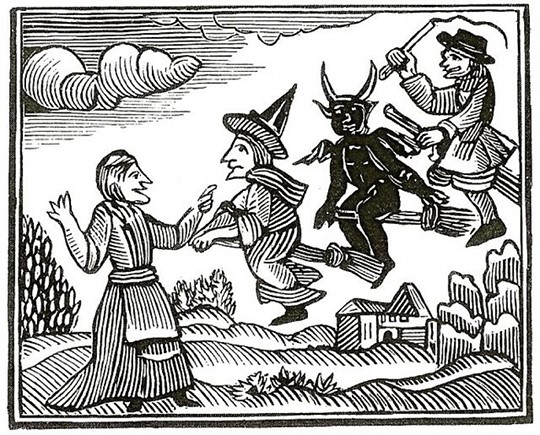James I and Witchcraft
Chapter 2 : Fear and Superstition
The early seventeenth century, when the witch hunts were at their height, was dominated by fear and superstition. In an increasingly unstable and volatile society, people clung ever more tightly to their deeply-held superstitions – even those who claimed to have embraced the reformed religion. The Kingdom of Darkness was as real to them as the Kingdom of Heaven, and ordinary people everywhere believed in devils, imps, fairies, goblins and ghosts, as well as legendary creatures such as vampires, werewolves and unicorns. Everyone feared evil portents, such as a hare crossing one's path or a picture falling from the wall. A pregnant woman must avoid gazing at the moon because it would render her baby insane.
Children were
frightened into obedience by their mothers or nursemaids with tales of evil
witches, spirits, elves and fantastical creatures. Women were grouped together with the sick and
infirm as being particularly susceptible to 'vain dreams and continual fear' as
a result of their 'weakness of mind and body.' Even grown men were afraid of the dark, for this is when it was believed
spirits most often appeared. 'Some never
fear the devil, but in a dark night…especially in a churchyard, where a right
hardy man heretofore scant durst pass by night but his hair would stand
upright.'

One of the earliest works on witchcraft, published in 1486, claimed: 'The imagination of some men is so vivid that they think they see actual figures and appearances which are but the reflection of their thoughts, and then these are believed to be the apparitions of evil spirits or even the spectres of witches.'
There was thus a
fertile ground for James's witch hunting beliefs to take hold. In 1597, he published
Daemonologie, a treatise on witchcraft that became so influential
that it was republished several times and distributed across Europe. It inspired a witch hunting fervour of
dangerous proportions, giving sanction to all manner of horrific persecutions. Those most at risk were women: as many as 95%
of those convicted for witchcraft were female. Most were unmarried, poor and misfits in their community. Many had a 'familiar', such as a cat, dog or
rat, which would supposedly help to carry out their evil spells.
The witch hunts
also became a convenient way of getting rid of troublesome neighbours. The old saying that there was 'no smoke
without fire' certainly held true here: an accusation was all that was needed
to bring someone to trial, and a staggeringly high proportion of those who were
hauled before the courts were found guilty.






